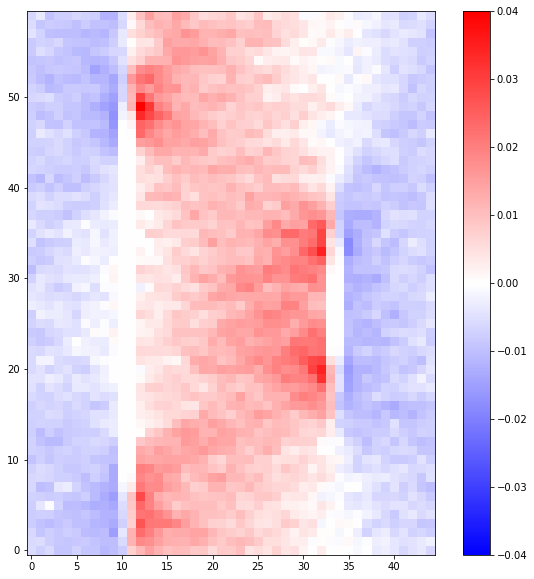Calculating Strain via Voxelization#
This notebook shows how to use freud’s neighbor finding to create a voxelized version of a system.
In brief, we are going to create a set of points that define the centers of our voxels, then assign all particles to one of these voxels. Then we sum up some property of the particles amongst all particles in a bin.
At the end we want to have a sampling of some particle property in our system on a regular grid (as a NumPy array).
[1]:
%matplotlib inline
import re
import freud
import matplotlib.pyplot as plt
import numpy as np
from scipy.sparse import csc_matrix, csr_matrix
This uses data from some text files that were output from the visualization software OVITO (https://ovito.org/)
The files have a header with box information, and then a list of particle info. These files have 10 fields per particle:
(ID#, position(x,y,z), strains(xx,yy,zz,yz,xz,xy))
The goal is to turn this into an \((N_x, N_y, N_z, 3, 3)\) NumPy array, where \(N_x, N_y, N_z\) are the number of bins in each dimension, and each of those bins has an averaged 3x3 strain array.
First we read in the box info from our text files and construct an average box. We need this so we can make our bin centers
[2]:
framefiles = [f"data/strain_data/frame{f}" for f in [100, 110, 120, 130]]
# read all the boxes, so we can make the grid points for voxelizing
boxes = []
for f in framefiles:
ff = open(f)
_ = ff.readline()
header = ff.readline()
match = re.match('^Lattice=".*"', header)
boxstring = match.group(0)
boxes.append(
np.array(str.split(boxstring[9:-1]), dtype=np.float32).reshape((3, 3)).T
)
ff.close()
# find the average box
ave_box = np.array(boxes).mean(axis=0)
Now we make the bin centers using np.meshgrid, but append and combine the X, Y, and Z coordinates into an array of shape \((N_x N_y N_z, 3)\) to pass to freud.
[3]:
res = (60, 10, 45) # The number of bins (in x,y,z)
xx = np.linspace(-ave_box[0, 0] / 2, ave_box[0, 0] / 2, num=res[0])
yy = np.linspace(-ave_box[1, 1] / 2, ave_box[1, 1] / 2, num=res[1])
zz = np.linspace(-ave_box[2, 2] / 2, ave_box[2, 2] / 2, num=res[2])
XX, YY, ZZ = np.meshgrid(xx, yy, zz)
XYZ = np.append(
np.append(XX.flatten().reshape((-1, 1)), YY.flatten().reshape((-1, 1)), axis=1),
ZZ.flatten().reshape((-1, 1)),
axis=1,
).astype(np.float32)
Now we iterate over our files and compute the first nearest neighbor (among the bin centers) of the particles, so we know which bin to average them in.
It is important to use scipy’s csr_matrix for this process when the number of particles is large. These files contain >80,000 particles, and without the sparse matrix, the dot product to determine grid totals would be extremely slow.
[4]:
master_strains = np.zeros((XYZ.shape[0], 6)) # matrix to sum into
for i in range(len(framefiles)):
data = np.loadtxt(framefiles[i], skiprows=2).astype(np.float32)
box = freud.box.Box(
Lx=boxes[i][0, 0],
Ly=boxes[i][1, 1],
Lz=boxes[i][2, 2],
yz=boxes[i][1, 2],
xz=boxes[i][0, 2],
xy=boxes[i][0, 1],
)
nlist = (
freud.AABBQuery(box, XYZ)
.query(data[:, 1:4], {"num_neighbors": 1})
.toNeighborList()
)
neighbors = nlist.point_indices
sprse = csr_matrix(
(np.ones(len(neighbors)), (neighbors, np.arange(len(neighbors)))),
shape=(XYZ.shape[0], len(neighbors)),
)
# strain data
sdata = data[:, 4:]
binned = np.zeros((XYZ.shape[0], 6))
# number of particles in each bin
grid_totals = sprse.dot(np.ones(len(neighbors)))
grid_totals[grid_totals == 0] = 1 # get rid of division errors
for j in range(6):
binned[:, j] = sprse.dot(sdata[:, j]) / grid_totals
master_strains = master_strains + binned
master_strains = master_strains / len(framefiles) # divide by number of frames
Now we pack up the resulting array into the shape we want it to be: \((N_x, N_y, N_z, 3, 3)\)
[5]:
final_matrix = np.zeros((res[1], res[0], res[2], 3, 3))
# this mapping turns 6 strain values into a symmetric (3,3) matrix
voigt_map = {0: (0, 0), 1: (1, 1), 2: (2, 2), 3: (1, 2), 4: (0, 2), 5: (0, 1)}
for i in range(6):
v = voigt_map[i]
final_matrix[:, :, :, v[0], v[1]] = master_strains[:, i].reshape(
res[1], res[0], res[2]
)
if v[0] != v[1]:
final_matrix[:, :, :, v[1], v[0]] = master_strains[:, i].reshape(
res[1], res[0], res[2]
)
Since we are only using four frames, the distribution is not very well sampled. But we can get a clue that a distinct distribution of strain is emerging if we average along the first axis of the matrix (this particular system should not vary in that direction)
[6]:
plt.figure(figsize=(10, 10))
plt.imshow(
final_matrix[:, :, :, 0, 0].mean(axis=0),
origin="lower",
cmap=plt.cm.bwr,
vmin=-0.04,
vmax=0.04,
interpolation="none",
)
plt.colorbar()
plt.show()
